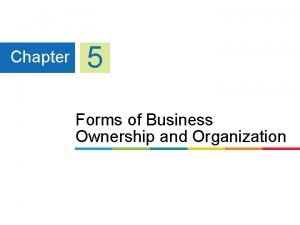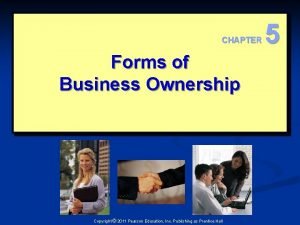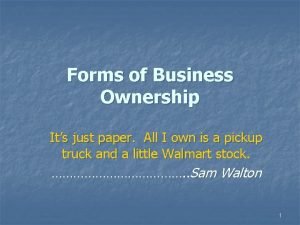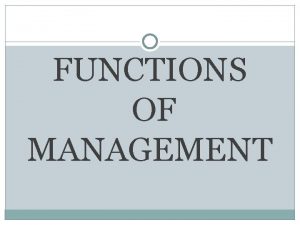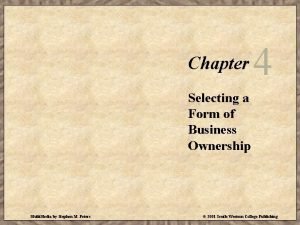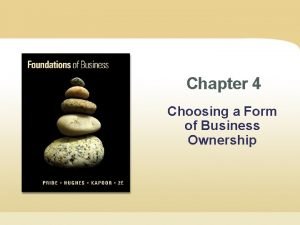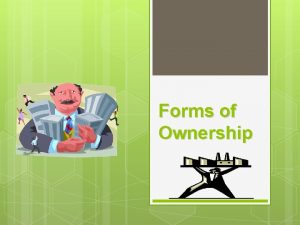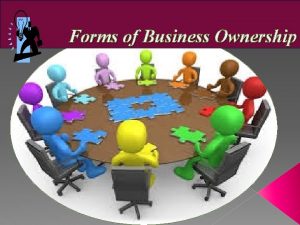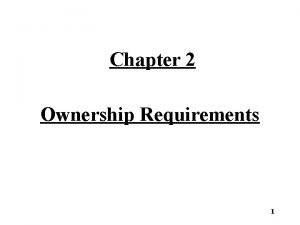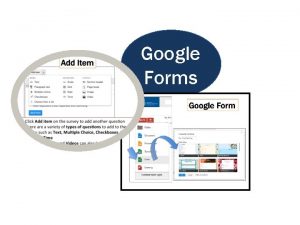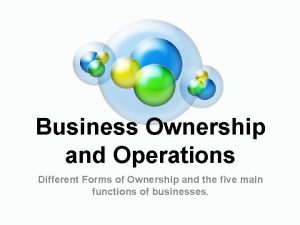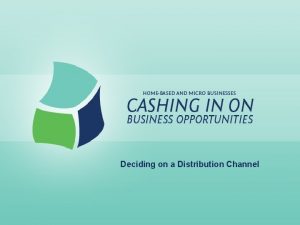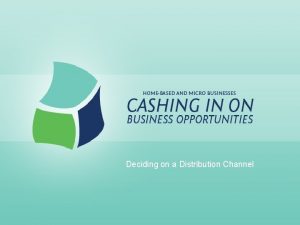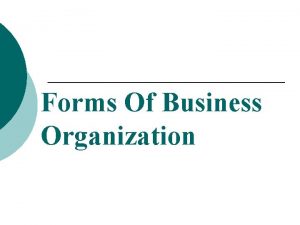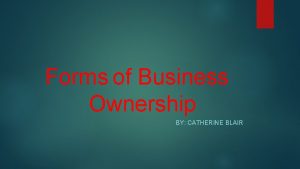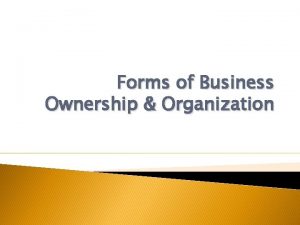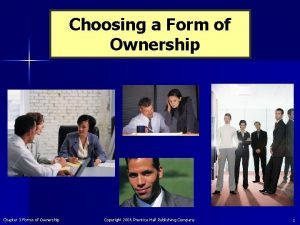Forms of Ownership 2 Deciding on the form

























- Slides: 25

Forms of Ownership

2 Deciding on the form of ownership of a company can have a huge impact on the success of the company. How do we decide on which form of ownership we should take? Factors that influence these decisions are: • Who will own the business? • Who will manage the business? • How will the business be taxed? • Capital - How will the business raise capital? • Continuity – What happens if the ownership changes? • Division of Profits – who gets what? • What legal capacity does the business have? • Legislation – what legislation impacts on the business The form of ownership also impacts the following: • Growth • Ability to raise capital • If they continue when ownership changes • Apply for government tenders • Enter into other contracts

3 The five different forms of Ownership are: 1. Sole Trader/Proprietor 2. Partnership 3. Close Corporation 4. Private Company 5. Public Company There are several pros and cons of each which can influence the success of the business. Sole Trader/Proprietor For • Self Interest • Easy start-up • Close relationship with suppliers and customers • Experience of all forms of business and management Against • Difficult to get good employees (security) • Unlimited liability for debt • No continuity • Limited capital for expansion • Only decision maker • Difficult to obtain capital/loans

4 Sole Trader – characteristics • One owner taking responsibility for everything • Personal interest in management and service delivered • No legal formalities • Name is owners choice – no legal requirements • Unlimited liability • No legal personality – therefore no continuity • Don’t have to audit financial statements • Can sell at anytime Partnership – characteristics • Agreement between two or more people • Provide own capital, controlled by partners • Joint control – personal interest in management • No legal formalities to start – just written partnership agreement (attorney must draw this up) • Unlimited liability – debts divided amongst partners depending on agreement, as are profits • Name is owners choice – no legal requirements • No legal personality – therefore no continuity • Auditing optional • Partner can transfer their share to someone else, with permission

5 Partnership For • Simple and inexpensive formation • Easy to obtain loans (partners jointly and severally liable) • Combined capital strengthens position • Unlimited liability • Combined skills, also able to specialise in best skills • Capital can be adjusted without legal procedures Against • Limited capital (contribution of 20 partners) • Actions of partners affect others • Lack of continuity • Slow decision making – consult other partners • 1 partners’ misfortune can affect others • Problems can develop between partners

6 Close corporation • • • No further registrations of cc’s permitted under new companies act Min of 1 and max of 10 members Each member makes a monetary, asset or service contribution Name ends in CC – close means all members involved and participate in management Limited liability – except where the CC has had more than ten members for six months or longer Own legal personality – unlimited continuity Auditing of books is optional – an accounting officer must check your books Can transfer members interest – all members must agree Interest expressed as a percentage – profits shared in relation to this

7 Close Corporation (CC) For Against • No meetings required • Limited liability • Easy and inexpensive to change founding statement (vision) • Registration also easy and cheap • Interest of members does not have to be in proportion with contributions • Capital restricted to contribution of 10 members • All members must agree on member leaving • Member can be liable for losses • Can not sell CC to a company, CC must convert, making sale complicated • Do not need auditing, but statements required for bank loans etc

8 Companies • Profit and non-profit companies • New companies act came into effect on May 1 2011 • All are governed by the companies act and are incorporated in terms of the Memorandum of Incorporation (MOI) Formation and registration of companies 1. One or more to start a profit company, three or more for a non-profit company 2. Draw up Memorandum of Incorporation 3. File it, together with a Notice of Incorporation 4. These two need to be registered at the Companies and Intellectual Property Commission (CIPC) 5. Once CICP are satisfied that all requirements are fulfilled for incorporation, a registration certificate is issued to the company • All companies are taxed on income of the business at a fixed rate (28%) • They also pay 10% Standard Tax of Company (STC) on members dividends

9 Profit Companies Private company – characteristics • Minimum one shareholder – no max shareholders • Minimum of one director, board of directors responsible for day-to-day running of the business • Cannot offer shares to the public • Shareholders have limited liability – only lose their initial capital if business goes bankrupt • Name must end in ‘(Pty) Ltd’ • Legal personality – continuity if people leave • Appointment of auditor – optional as well as auditing financial statements • Raises own capital – issuing shares to its shareholders • Profits shared in the form of dividends in proportion to shares held

10 Private Company For Against • Suitable for people which have good ideas but limited capital • Unlimited shareholders– more share capital can be raised • Limited liability • No meeting required • Act forces personal liability on directors who are knowingly involved in reckless or fraudulent business • Not required to file annual financial statements • Board of directors of choice can be appointed - experience • Double tax – taxable income and tax on dividends distributed • No members of general public can buy shares • Cannot be listed on JSE • Difficult and expensive to establish • Financial statements must be reviewed by qualified person – extra expense

11 Public Company – characteristics • Minimum of one person required to start up • Capital raised from public and by being listed on the JSE • MOI allows public companies to sell shares to the public • Shareholders have no personal interest in management • Minimum of three directors required • Additional of three directors needed for audit committee • Three for social and ethics committee • Shareholders elect 50% of directors • Shareholders have limited liability • Act forces personal liability on directors who are knowingly involved in reckless or fraudulent business • Name of company must end in ‘Ltd’ • Unlimited continuity • Required to hold an AGM (Annual General Meeting) • Auditing of financial statements compulsory, those statements are available to shareholders and public • Profits shared as dividends in proportion to shares held • Company raises own capital by issuing shares to public and borrowing capital by offering debentures • Prospectus issued to public to raise capital

12 Public Company For Against • Losses are not harsh due to amount of shareholders – separate legal identity • Investors can buy shares in several companies – spread risk • Large amount of capital can be raised – shares and debentures • Small investors have a part in the economy • Competent directors can be appointed • Only one person needed to start • Shareholders have limited liability • Public have access to info – maybe motivating them to buy shares • Double tax – taxable income and tax on dividends distributed • Shareholders may have little or no impact on decisions • Expensive formation costs and complicated procedures • Have to publish financial reports, helpful to competitors • High admin costs (shares) • Failure of large companies have terrible results • Memorandum of Association cannot be changed easily • More people to share profits with – less income • Decisions/disagreements take longer

13 State-Owned Company (SOC) Ltd • Government owned and operated for profit • Listed as public companies Advantages • Limited liability for shareholders • Support of government • SOC has greater power when negotiating with businesses Disadvantages • Shares not freely tradable – difficult to raise capital • Strict regulations for operation functions • More ‘red tape’ – costs more • Financial statements must be audited • Red tape – collection and completion of forms and procedures for approval for something

14 Personal Liability Incorporated (Inc. ) • All directors (past and present) are severally liable together with the company for any debts during their term as directors • These are used for professional services – engineers, attorney and accountants Advantages Same as private company except shareholders do not have limited liability Disadvantages • Same as private company • Unlimited personal liability

15 Non-Profit company (NPC) • Not formed with the intent to make a profit, but established for public benefit • Could be religious, charitable, educational, literary or scientific purpose • Income and property may not be distributed to the incorporators, members, directors or officers • Profits must be retained for existence and expansion • Staff may be paid but many are volunteers • Funded by donations – tax deductible if from the private or public sector • NPOs are tax-exempt Advantages • • • Free from income tax Donations are tax exempt Can receive grants or aid Contributes to social development Surplus of income retained for company improvements Disadvantages • • • Creation takes time and effort Stricter reporting requirements No personal gain for members etc Getting grants can be slow Incorporators cannot take along assets accumulated when they leave

16 Co-Operatives • Organisation formed by group of people who agree to work together and pool their resources so they can be more economically effective • Act of 2005 – five people needed top establish a co-op • Must register with CIPC Advantages • Co-op has continuity • Limited liability for members • Resources of many pooled together • Not large amount of money needed (depending on type) • All members help in running business • Profits shared equally Disadvantages • Decision making time consuming – all members have an equal say • All members have one vote, no matter how much interest they have • Difficult to get a loan – main objective is not always to make a profit

17 Types of ownership and their impact on the success of a business • The following factors should be taken into consideration when choosing the form of ownership of a business: Formation Procedures • Some are easier than others, following factors taken into consideration: • Sole trader – easy and inexpensive • Partnership – as above, plus agreement • CC – Founding Statement and Name Reservation • Companies – most expensive to establish. Memorandum of Inc and a Notice to Incorporate filed to CIPC • The more legal requirements in formation – the more costly and time consuming • High start-up costs affect a business’ cash flow and can put pressure on a new business • Legal requirements, e. g. , auditing and publication of financial statements further contribute to costs in the business

18 Continuity of the Enterprise • Ability to survive independently from its owners • Sole traders and partnerships depend on the owners lives – no continuity • CC’s and companies have UNlimited continuity – not dependent on owners to keep going. • Sole Trader & Partnership businesses do NOT pay tax. • The owner/partners pay tax. • Owners are legal people/entity not the business! • Limited continuity can put pressure on a business if a current form of ownership ends • Directors can die or retire and the Company continues to “live”! • The Company is the legal “person” or entity. . . not the owners or directors. • SO BASICALLY : ) • UNLIMITED CONTINUITY = CC & Companies • LIMITED CONTINUITY = SOLE TRADER & PARTNERSHIPS

19 Legal Personality and Liability • Protection of personal assets is an important factor in ownership Taxation Sole Traders and Partnership – personal tax on profits they earn, up to a max of 40% - progressive tax system CC’s and Companies – fixed rate of tax (28%) on profits, shareholders pay a further 15% dividends tax Sole traders, partnerships and incorporated businesses – that turnover less than R 1 million may register as micro businesses – pay tax at a max rate of 7% on turnover

20 Taxation • All people earning an income above a certain amount must pay tax!! • Businesses generate income and must therefore pay tax • Your business must be registered to pay tax • Non legal entities • Sole traders & partnerships only register the name of the sole trader or the partners. Sole Trader & Partnership businesses do NOT pay tax. The owner/partners pay tax. Owners are legal people/entity not the business!! • Legal Entities • CC’s & Companies must register their name of the CC or company. • Legal entities by law must have something after their name: • Close Corporation = CC • Private Company = (Pty) Ltd or Public Comapny = Ltd • Members and shareholders of both the above still pay personal tax.

21 Sole Trader • Calculates by taking their income and then deducting all expenses. P = I -E • Profit is added to any other income the owner receives and taxed accordingly • Owner is taxed not the business itself. Owner = legal person. Partnership • Calculates by taking the income of the partnership and then deducting all expenses. P=I-E • The partners pay tax in a personal capacity • Partners are taxed not the Partnership business itself. • Profit is added to any other income the partners receive and taxed accordingly • Close Corporation • Pays tax on income brought into the business after taking away expenses of the business • Profits belong to the CC • Income tax is payable at 28% • Profit (after tax) is distributed to members • Shareholders then pay a further 15% on all dividends received

22 Companies • Pays tax on income brought into the business after taking away expenses of the business. P=I-E • Profit belongs to the company • Companies pay tax at 28% of taxable income • Profit after tax is distributed to shareholders – dividends • Shareholders also pay a further 15% tax on any dividend received Special Tax • Some small CC’s and private companies qualify for a reduced tax rate

23 Capacity and Management Capacity is therefore influenced by legal status NB!! If a business is not a legal entity there is not separation between the owner and the business An Owner: • Enters into contracts • Pays tax • Lends/borrows money in their personal capacity as they are the business • Remember the laws differentiates between members of a CC and directors of companies • Members, shareholders and directors act on behalf of the business and not in a personal capacity

24 Sole Trader ONE owner • No difference between personal and business assets & debts. • Owner goes bankrupt not the business. UNlimited liability • Usually managed by owner but managers are sometimes appointed to manage the business Partnership 2 to 20 Parners (owners) • As above with both assets and debts • Law does also not recognise the difference between assets of different partners, therefore the debt of one partner can become the debt of another. UNlimited liability • Partners decide who will manage the business Close Corporation CC (1 to 10 members) discountinued. • Owners and managers called members. • Each member has an interest of the business (expressed a s a %) • Total interest 100% • CC is legally separate from its members = limited liability • Therefore assets and liabilities are the businesses not the members • All members manage the business in some way

25 Private Company (Pty)Ltd • Have shareholders and directors • Shareholders can be people of other businesses • Shareholders own the company, directors run it • Company is legally separate from shareholders and directors Public Company Ltd • Legally the same as a private company • Companies are managed by a board of directors – voted in by shareholders (owners) at the AGM Capital Requirements • The amount of capital needed to start a business will depend on the size of the business and type of product or service offered • Eg – a medium size business that needs expensive machinery for manufacturing will need more capital than a business offering a service • Small – medium businesses are usually set up as partnerships or sole traders eg hairdressers, mechanics etc • Growth in these companies will depend on success and the ability of the owners to make cash available for the business
 Three basic forms of business ownership
Three basic forms of business ownership What is sole proprietorship example?
What is sole proprietorship example? Chapter 5 business organization
Chapter 5 business organization Basic forms of ownership
Basic forms of ownership Forms of business ownership assignment
Forms of business ownership assignment Deciding to marry asl story
Deciding to marry asl story Batasan perencanaan
Batasan perencanaan Planning is deciding in advance what is to be done
Planning is deciding in advance what is to be done Deciding on the global marketing organization
Deciding on the global marketing organization Consensual vs top down
Consensual vs top down Why do maycomb officials bend the rules for the ewells
Why do maycomb officials bend the rules for the ewells Form of ownership example
Form of ownership example Business ownership
Business ownership Selecting a form of business ownership
Selecting a form of business ownership Why are related forms more agreeable than unrelated forms
Why are related forms more agreeable than unrelated forms Long or contracted forms
Long or contracted forms Why are related forms more agreeable than unrelated forms
Why are related forms more agreeable than unrelated forms Why are related forms more agreeable than unrelated forms?
Why are related forms more agreeable than unrelated forms? Strong forms
Strong forms Present continuous affirmative
Present continuous affirmative Hát kết hợp bộ gõ cơ thể
Hát kết hợp bộ gõ cơ thể Slidetodoc
Slidetodoc Bổ thể
Bổ thể Tỉ lệ cơ thể trẻ em
Tỉ lệ cơ thể trẻ em Voi kéo gỗ như thế nào
Voi kéo gỗ như thế nào Tư thế worm breton
Tư thế worm breton


